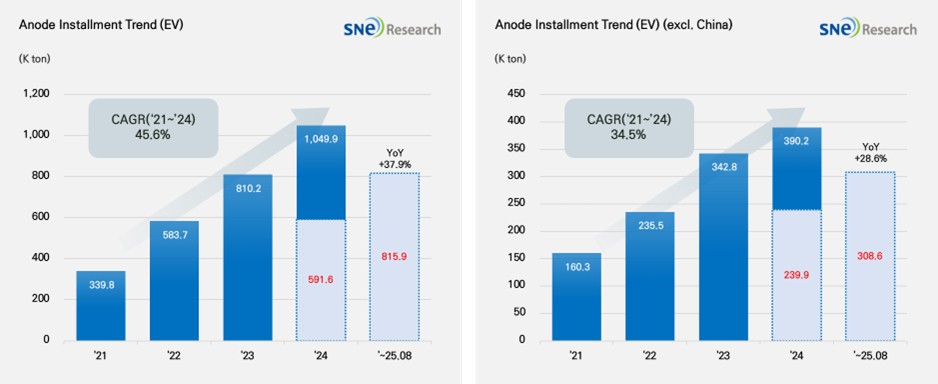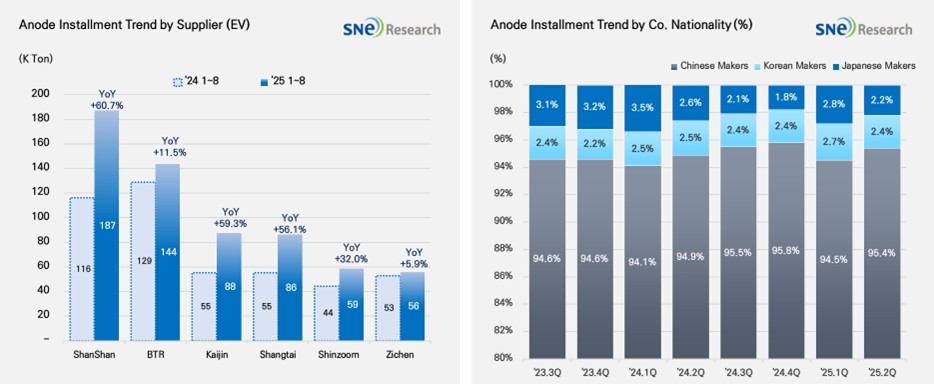From Jan to Aug in 2025, Global[1] Electric Vehicle Battery Anode Material Installment[2] Reached 816K ton, a 37.9% YoY Growth
- Anode installment in the non-China market recorded 309K ton, a 28.6% YoY growth

(Source: 2025 Sep Global EV & Battery Monthly Tracker (Incl. LiB 4 Major Materials), SNE Research)
From Jan to Aug 2025, the total installment of anode materials in electric vehicles (EV, PHEV, HEV) registered worldwide was approx. 816K ton, posting a 37.9% YoY growth and staying in an upward trend. During the same period, in the global market outside China, the total installment of anode materials was 309K ton, recording a 28.6% growth. Despite relatively moderate growth, the overall trend of steady growth was maintained.
If we look at the market shares held by companies, ShanShan (187K ton) and BTR (144K ton) ranked 1st and 2nd on the list, leading the global anode market. These two companies have successfully secured a stable customer based and mass production capabilities, by supplying anode materials to major battery makers such as CATL, BYD, and LG Energy Solution. Kaijin (788K ton), Shangtai (86 K ton), Shinzoom (59 K ton), Zichen (56K ton) were all ranked high, exhibiting a double-digit YoY growth and expanding their presence in the global market.

(Source: 2025 Sep Global EV & Battery Monthly Tracker (Incl. LiB 4 Major Materials), SNE Research)
If we look at the market shares of companies by their nationality, the Chinese anode makers accounted for more than 95% of the entire market, solidifying their absolute dominance in the market. Based on expansion of production capacity and sophistication of technology, they have been solidifying their market dominance. With the electric vehicle market expanded, more Si-anode has been adopted, leading them to further intensify cooperation with major battery makers. Although the market shares taken by the Korean anode makers were only around 2.4%, cooperation with major cell makers has been expanded to enter the market in earnest. Those efforts to cooperate with cell makers are mainly led by POSCO and Daejoo. On the other hand, the Japanese anode manufacturers accounted for only 2.2% of the market share, showing a relatively insignificant presence in the market. For example, Hitachi and Mitsubishi maintained their conservative strategies to depend on the existing customer base, which seemed to gradually weaken their competitiveness in the market.
The anode materials market is entering a new transition phase, as demand for conventional natural and synthetic graphite remains solid while recently increasing U.S. tariffs and the shift toward next-generation batteries intersect. In July 2025, the U.S. Department of Commerce issued a preliminary ruling to impose anti-dumping and countervailing duties on synthetic graphite for anode materials imported from China, which directly influenced procurement strategies of battery manufacturers in North America. Consequently, efforts are accelerating in the United States to develop alternative materials to graphite and to secure non-China-based anode supply chains. At the same time, Si composite anode material has emerged as an alternative to conventional anode materials in terms of high energy density, fast charging, and battery life. To take advantage of Si composite anode material, anode suppliers in the US, Korea, and Europe have been rapidly enhancing related commercialization technology and increasing production capacities.
A key to strategies for anode manufacturers is taking regulations as an opportunity. In the short term, they need to diversify production bases in North America and Southeast Asia and to develop in-house production of synthetic graphite in order to lower their dependence on China. In the mid-term, success of anode makers relies on how fast they can achieve satisfactory yield of silicon and carbon composite while lowering the production cost. Those companies, who will seamlessly connect the whole supply chain from raw material procurement, refinement, precursor, anode material, electrolyte, cell, and to pack as well as strengthen the cooperation network throughout North America, Europe, and Asia, are expected to take an advantageous position in the market by responding to fluctuations in the market. Eventually, a key to success for anode suppliers from 2025 to 2027 will be dependent on whether they focus on solidifying their supply and cooperation chains rather than ramping up their capacities.
[2] Based on batteries installed to electric vehicles registered during the relevant period.

